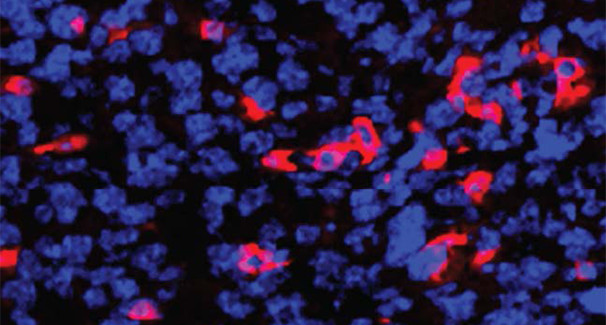
Technologies to improve bone grafts and cancer immunotherapies, protect lung tissue during radiation treatment, reverse neurological damage and improve recovery from spinal cord injury are among the patents issued to the University of Louisville Research Foundation recently. Two of the inventions have been licensed and are in the process of making their way into the health-care system to improve the lives of patients.
• Bone graft cement – A substitute bone graft material called Trabexus EB has been patented and cleared by the FDA for use by orthopaedic surgeons in patient care. The product, developed by Michael Voor, Ph.D., associate professor of orthopaedic surgery and bioengineering at UofL, along with Robert Burden, M. Eng., a former student and employee of the Orthopaedic Bioengineering Lab, is a bone replacement cement that provides both strength and resorbability in bone repairs. Licensed and marketed by Vivorte, Trabexus EB contains specially shaped bone particles, called Trabs, which interconnect to provide a biologically active framework for the bone repair. The specially formulated calcium phosphate that binds the particles together allows the material to flow into irregular void spaces then provides strength while allowing the body to resorb the material and replace it with living bone. Trabexus EB is used by orthopaedic surgeons in repairing bones damaged through injury, tumor or other defects.
• Revolutionary treatment for paralysis – A three-pronged approach to the treatment of paralysis following spinal cord injury has received a patent based on the research of Susan Harkema, Ph.D., and Claudia Angeli, Ph.D., of UofL’s Kentucky Spinal Cord Injury Research Center, along with researchers at UCLA and elsewhere. The treatment method centers on the use of epidural stimulation to activate the spinal cord, along with physical training and medications that when combined, allow individuals with spinal cord injury to have voluntary control of body movements and improve heart, lung and other autonomic functions. To activate the spinal circuits, an electrode array, controlled by the patient, is implanted in the lower spine. Participants in epidural stimulation research at UofL have experienced the ability to move and stand unassisted with some improvements in heart, pulmonary and bladder function.
• Cancer therapy improvement – Haval Shirwan, Ph.D., endowed chair and professor in UofL’s Institute for Cellular Therapeutics, along with Esma Yolcu, Ph.D., of UofL and Kutlu Elpek, Ph.D., now of Boston, have developed a method of using a series of ligands, molecules that bind to cell receptors, to enhance immunotherapies used for the treatment of cancer and chronic viral infections, such as HIV. When diseases such as cancer and HIV have overcome the patient’s immune system, the T cells, which provide a natural immune response, are “switched off.” The patented compositions utilize specific ligands in combination with antigens or infectious agents to reactivate and generate new T cells, allowing the patient’s immune system to respond more vigorously in eliminating the tumors or disease and preventing recurrence. This method of stimulating the immune system has significant potential to make immunotherapies more effective and provide protection against recurrence of the disease.
• Protecting lung function – Software to detect areas of depleted lung function during radiation treatment for lung cancer is the subject of a patent based on the work of Shiao Woo, M.D., chair, and Neal Dunlap, M.D., assistant professor of radiation oncology at UofL, along with Amir Amini, Ph.D., professor and endowed chair in bioimaging at UofL’s J.B. Speed School of Engineering, and Mohammadrezza Negahdar, Ph.D., now at Stanford University. The group developed 4-D computed tomography (CT) image analysis software that can be incorporated into existing lung imaging used during radiation therapy to detect early changes in lung elasticity. If specific areas of the lung have been damaged by radiation, the treatments can be adjusted to prevent permanent breathing problems. The process also may be used in other lung diseases, such as fibrosis, to detect early changes in lung function.
• Repairing the spinal cord – Fred Roisen, Ph.D., former chair of the UofL Department of Anatomical Sciences and Neurobiology, along with UofL researchers Meng Qiu, Ph.D., and Chengliang Lu, M.D., and UofL graduate Meng Wang, Ph.D., developed a method for a tissue biopsy from a patient’s nasal passages and from those cells, isolating progenitor stem cells called RhinoCytes. These RhinoCtyes regenerate the spinal cord to repair an injury. The stem cells also can be used in the treatment of Parkinson’s Disease, amyotrophic lateral sclerosis (ALS), multiple sclerosis and type 1 diabetes. The method of generating the RhinoCytes has been licensed from UofL by RhinoCyte, Inc., and is scheduled for a concept study at the University of Louisville Hospital with Phase I/II clinical trials beginning in 2016.
These patents have been awarded to the University of Louisville Research Foundation, Inc., in the current fiscal year, which began in July, 2015, according to the office of Technology Transfer & Industry Engagement. That office works with UofL researchers to submit patent applications and negotiates commercialization opportunities for patented technologies. The university received 60 U.S. patents in the past two fiscal years, half of which are related to medical research at the School of Medicine. The Speed School of Engineering is responsible for most of the other patent applications.
UofL is the only university with three of the most prestigious innovation-associated commercialization grants, having received grants from the Coulter Translational Research Partnership, the National Science Foundation’s I-Corps and the National Institutes of Health Research Evaluation and Commercialization Hub (REACH).


































